Organic Rankine Cycle (ORC) System Applications for Solar Energy: Recent Technological Advances
Abstract
:1. Introduction
2. Methodology
3. Results and Discussion
3.1. Patent Landscape
3.2. Technology Updates
3.2.1. Parabolic Dish
3.2.2. Parabolic Trough
3.2.3. Solar Tower
3.2.4. Linear Fresnel Reflector
3.2.5. Technology Updates
4. Conclusions
Author Contributions
Funding
Conflicts of Interest
References
- Anderson, T.R.; Hawkins, E.; Jones, P.D. CO2, the greenhouse effect and global warming: From the pioneering work of Arrhenius and Callendar to today’s Earth System Models. Endeavour 2016, 40, 178–187. [Google Scholar] [CrossRef]
- Mahlia, T.M.I. Emissions from electricity generation in Malaysia. Renew. Energy 2002, 27, 293–300. [Google Scholar] [CrossRef]
- Norhasyima, R.S.; Mahlia, T.M.I. Advances in CO₂ utilization technology: A patent landscape review. J. CO₂ Util. 2018, 26, 323–335. [Google Scholar] [CrossRef]
- Masjuki, H.H.; Mahlia, T.M.I.; Choudhury, I.A.; Saidur, R. Potential CO2 reduction by fuel substitution to generate electricity in Malaysia. Energy Convers. Manag. 2002, 43, 763–770. [Google Scholar] [CrossRef]
- Mahlia, T.M.I.; Lim, J.Y.; Aditya, L.; Riayatsyah, T.M.I.; Abas, A.P. Nasruddin, Methodology for implementing power plant efficiency standards for power generation: Potential emission reduction. Clean Technol. Environ. Policy 2018, 20, 309–327. [Google Scholar] [CrossRef]
- Bel, G.; Joseph, S. Climate change mitigation and the role of technological change: Impact on selected headline targets of Europe’s 2020 climate and energy package. Renew. Sustain. Energy Rev. 2018, 82, 3798–3807. [Google Scholar] [CrossRef]
- Davy, R.; Gnatiuk, N.; Pettersson, L.; Bobylev, L. Climate change impacts on wind energy potential in the European domain with a focus on the Black Sea. Renew. Sustain. Energy Rev. 2018, 81, 1652–1659. [Google Scholar] [CrossRef] [Green Version]
- do Nascimento Nadruz, V.; Lucia Casteli Figueiredo Gallardo, A.; Montaño, M.; Ramos, H.R.; Ruiz, M.S. Identifying the missing link between climate change policies and sectoral/regional planning supported by Strategic Environmental Assessment in emergent economies: Lessons from Brazil. Renew. Sustain. Energy Rev. 2018, 88, 46–53. [Google Scholar] [CrossRef]
- Wang, B.; Wang, Q.; Wei, Y.M.; Li, Z.P. Role of renewable energy in China’s energy security and climate change mitigation: An index decomposition analysis. Renew. Sustain. Energy Rev. 2018, 90, 187–194. [Google Scholar] [CrossRef]
- Wang, D.D.; Sueyoshi, T. Climate change mitigation targets set by global firms: Overview and implications for renewable energy. Renew. Sustain. Energy Rev. 2018, 94, 386–398. [Google Scholar] [CrossRef]
- Wang, L.; Huang, G.; Wang, X.; Zhu, H. Risk-based electric power system planning for climate change mitigation through multi-stage joint-probabilistic left-hand-side chance-constrained fractional programming: A Canadian case study. Renew. Sustain. Energy Rev. 2018, 82, 1056–1067. [Google Scholar] [CrossRef]
- Abas, P.E.; Mahlia, T. Techno-Economic and Sensitivity Analysis of Rainwater Harvesting System as Alternative Water Source. Sustainability 2019, 11, 2365. [Google Scholar] [CrossRef]
- Demirbas, A. Progress and recent trends in biodiesel fuels. Energy Convers. Manag. 2009, 50, 14–34. [Google Scholar] [CrossRef]
- Demirbas, A.D.M.F. Algae Energy: Algae as a New Source of Biodiesel; Springer: Berlin/Heidelberg, Germany, 2010. [Google Scholar]
- Ding, L.; Yoshikawa, K.; Fukuhara, M.; Kowata, Y.; Nakamura, S.; Xin, D.; Muhan, L. Development of an ultra-small biomass gasification and power generation system: Part 2. Gasification characteristics of carbonized pellets/briquettes in a pilot-scale updraft fixed bed gasifier. Fuel 2018, 220, 210–219. [Google Scholar] [CrossRef]
- Ghaffarpour, Z.; Mahmoudi, M.; Mosaffa, A.H.; Garousi Farshi, L. Thermoeconomic assessment of a novel integrated biomass based power generation system including gas turbine cycle, solid oxide fuel cell and Rankine cycle. Energy Convers. Manag. 2018, 161, 1–12. [Google Scholar] [CrossRef]
- Lan, W.; Chen, G.; Zhu, X.; Wang, X.; Liu, C.; Xu, B. Biomass gasification-gas turbine combustion for power generation system model based on ASPEN PLUS. Sci. Total Environ. 2018, 628, 1278–1286. [Google Scholar] [CrossRef]
- Hamzah, N.; Tokimatsu, K.; Yoshikawa, K. Prospective for Power Generation of Solid Fuel from Hydrothermal Treatment of Biomass and Waste in Malaysia; Energy Procedia; Elsevier: Amsterdam, The Netherlands, 2017; Volume 142, pp. 369–373. [Google Scholar]
- Sajdak, M. Development and validation of new methods for identification of bio-char as an alternative solid bio-fuel for power generation. Fuel Process. Technol. 2017, 167, 229–240. [Google Scholar] [CrossRef]
- Ahmed, A.; Abu Bakar, M.S.; Azad, A.K.; Sukri, R.S.; Mahlia, T.M.I. Potential thermochemical conversion of bioenergy from Acacia species in Brunei Darussalam: A review. Renew. Sustain. Energy Rev. 2018, 82, 3060–3076. [Google Scholar] [CrossRef]
- Mehrali, M.; Latibari, S.T.; Mehrali, M.; Mahlia, T.M.I.; Metselaar, H.S.C.; Naghavi, M.S.; Sadeghinezhad, E.; Akhiani, A.R. Preparation and characterization of palmitic acid/graphene nanoplatelets composite with remarkable thermal conductivity as a novel shape-stabilized phase change material. Appl. Therm. Eng. 2013, 61, 633–640. [Google Scholar] [CrossRef]
- Mardoyan, A.; Braun, P. Analysis of Czech subsidies for solid biofuels. Int. J. Green Energy 2015, 12, 405–408. [Google Scholar] [CrossRef]
- Aditiya, H.B.; Chong, W.T.; Mahlia, T.M.I.; Sebayang, A.H.; Berawi, M.A.; Nur, H. Second generation bioethanol potential from selected Malaysia’s biodiversity biomasses: A review. Waste Manag. 2016, 47, 46–61. [Google Scholar] [CrossRef]
- Aditiya, H.B.; Mahlia, T.M.I.; Chong, W.T.; Nur, H.; Sebayang, A.H. Second generation bioethanol production: A critical review. Renew. Sustain. Energy Rev. 2016, 66, 631–653. [Google Scholar] [CrossRef]
- Dharma, S.; Masjuki, H.H.; Ong, H.C.; Sebayang, A.H.; Silitonga, A.S.; Kusumo, F.; Mahlia, T.M.I. Optimization of biodiesel production process for mixed Jatropha curcas-Ceiba pentandra biodiesel using response surface methodology. Energy Convers. Manag. 2016, 115, 178–190. [Google Scholar] [CrossRef]
- Kusumo, F.; Silitonga, A.S.; Masjuki, H.H.; Ong, H.C.; Siswantoro, J.; Mahlia, T.M.I. Optimization of transesterification process for Ceiba pentandra oil: A comparative study between kernel-based extreme learning machine and artificial neural networks. Energy 2017, 134, 24–34. [Google Scholar] [CrossRef]
- Silitonga, A.S.; Atabani, A.E.; Mahlia, T.M.I.; Masjuki, H.H.; Badruddin, I.A.; Mekhilef, S. A review on prospect of Jatropha curcas for biodiesel in Indonesia. Renew. Sustain. Energy Rev. 2011, 15, 3733–3756. [Google Scholar] [CrossRef]
- Manzano-Agugliaro, F.; Taher, M.; Zapata-Sierra, A.; Juaidi, A.; Montoya, F.G. An overview of research and energy evolution for small hydropower in Europe. Renew. Sustain. Energy Rev. 2017, 75, 476–489. [Google Scholar] [CrossRef]
- Ak, M.; Kentel, E.; Savasaneril, S. Operating policies for energy generation and revenue management in single-reservoir hydropower systems. Renew. Sustain. Energy Rev. 2017, 78, 1253–1261. [Google Scholar] [CrossRef]
- Lopes, V.S.; Borges, C.L.T. Impact of the Combined Integration of Wind Generation and Small Hydropower Plants on the System Reliability. IEEE Trans. Sustain. Energy 2015, 6, 1169–1177. [Google Scholar] [CrossRef]
- Nakamura, Y.; Komatsu, H.; Shiratori, S.; Shima, R.; Saito, S.; Miyagawa, K. Development of high-efficiency and low-cost shroudless turbine for small hydropower generation plant. In Proceedings of the ICOPE 2015—International Conference on Power Engineering, Yokohama, Japan, 30 November–4 December 2015. [Google Scholar]
- Zerrahn, A. Wind Power and Externalities. Ecol. Econ. 2017, 141, 245–260. [Google Scholar] [CrossRef]
- Chong, W.T.; Naghavi, M.S.; Poh, S.C.; Mahlia, T.M.I.; Pan, K.C. Techno-economic analysis of a wind-solar hybrid renewable energy system with rainwater collection feature for urban high-rise application. Appl. Energy 2011, 88, 4067–4077. [Google Scholar] [CrossRef]
- Rocha, L.C.S.; Aquila, G.; Rotela Junior, P.; Paiva, A.P.D.; Pamplona, E.D.O.; Balestrassi, P.P. A stochastic economic viability analysis of residential wind power generation in Brazil. Renew. Sustain. Energy Rev. 2018, 90, 412–419. [Google Scholar] [CrossRef]
- Sarfati, M.; Hesamzadeh, M.R.; Biggar, D.R.; Baldick, R. Probabilistic pricing of ramp service in power systems with wind and solar generation. Renew. Sustain. Energy Rev. 2018, 90, 851–862. [Google Scholar] [CrossRef]
- Cao, L.; Qian, Z.; Zareipour, H.; Wood, D.; Mollasalehi, E.; Tian, S.; Pei, Y. Prediction of Remaining Useful Life of Wind Turbine Bearings under Non-Stationary Operating Conditions. Energies 2018, 11, 3318. [Google Scholar] [CrossRef]
- Pioro, I.; Duffey, R. Nuclear Power as a Basis for Future Electricity Generation. J. Nucl. Eng. Radiat. Sci. 2015, 1, 011001. [Google Scholar] [CrossRef]
- Koyama, K. Nuclear power generation. Yosetsu Gakkai Shi/J. Jpn. Weld. Soc. 2014, 83, 23–28. [Google Scholar] [CrossRef]
- Pioro, I. Nuclear power as a basis for future electrical-energy generation in the world. In Proceedings of the International Congress on Advances in Nuclear Power Plants, ICAPP 2014, Charlotte, NC, USA, 6–9 April 2014; pp. 2387–2400. [Google Scholar]
- Karim, R.; Karim, M.; Muhammad-Sukki, F.; Abu-Bakar, S.; Bani, N.; Munir, A.; Kabir, A.; Ardila-Rey, J.; Mas’ud, A. Nuclear Energy Development in Bangladesh: A Study of Opportunities and Challenges. Energies 2018, 11, 1672. [Google Scholar] [CrossRef]
- Janjai, S. A method for estimating direct normal solar irradiation from satellite data for a tropical environment. Sol. Energy 2010, 84, 1685–1695. [Google Scholar] [CrossRef]
- Ismail, M.S.; Moghavvemi, M.; Mahlia, T.M.I. Genetic algorithm based optimization on modeling and design of hybrid renewable energy systems. Energy Convers. Manag. 2014, 85, 120–130. [Google Scholar] [CrossRef]
- Ismail, M.S.; Moghavvemi, M.; Mahlia, T.M.I. Design of an optimized photovoltaic and microturbine hybrid power system for a remote small community: Case study of Palestine. Energy Convers. Manag. 2013, 75, 271–281. [Google Scholar] [CrossRef]
- Ismail, M.S.; Moghavvemi, M.; Mahlia, T.M.I. Analysis and evaluation of various aspects of solar radiation in the Palestinian territories. Energy Convers. Manag. 2013, 73, 57–68. [Google Scholar] [CrossRef]
- Aditya, L.; Mahlia, T.M.I.; Rismanchi, B.; Ng, H.M.; Hasan, M.H.; Metselaar, H.S.C.; Muraza, O.; Aditiya, H.B. A review on insulation materials for energy conservation in buildings. Renew. Sustain. Energy Rev. 2017, 73, 1352–1365. [Google Scholar] [CrossRef]
- Amin, M.; Putra, N.; Kosasih, E.A.; Prawiro, E.; Luanto, R.A.; Mahlia, T.M.I. Thermal properties of beeswax/graphene phase change material as energy storage for building applications. Appl. Therm. Eng. 2017, 112, 273–280. [Google Scholar] [CrossRef]
- Korobitsyn, M.A. New and Advanced Energy Conversion Technologies: Analysis of Cogeneration, Combined and Integrated Cycles; University of Twente: Enschede, The Netherlands, 1998. [Google Scholar]
- Prasetyo, P. Studi Penentuan Geometri Turbin Radial Aliran Masuk pada Siklus Rankine Organik Dengan Fluida Kerja R134a; Bandung Institute of Technology: Bandung, Indonesia, 2015. [Google Scholar]
- Bellos, E.; Tzivanidis, C. Investigation of a hybrid ORC driven by waste heat and solar energy. Energy Convers. Manag. 2018, 156, 427–439. [Google Scholar] [CrossRef]
- Dumont, O.; Dickes, R.; De Rosa, M.; Douglas, R.; Lemort, V. Technical and economic optimization of subcritical, wet expansion and transcritical Organic Rankine Cycle (ORC) systems coupled with a biogas power plant. Energy Convers. Manag. 2018, 157, 294–306. [Google Scholar] [CrossRef] [Green Version]
- Sadreddini, A.; Fani, M.; Ashjari Aghdam, M.; Mohammadi, A. Exergy analysis and optimization of a CCHP system composed of compressed air energy storage system and ORC cycle. Energy Convers. Manag. 2018, 157, 111–122. [Google Scholar] [CrossRef]
- Saloux, E.; Sorin, M.; Nesreddine, H.; Teyssedou, A. Reconstruction procedure of the thermodynamic cycle of organic Rankine cycles (ORC) and selection of the most appropriate working fluid. Appl. Therm. Eng. 2018, 129, 628–635. [Google Scholar] [CrossRef]
- Vera, D.; Jurado, F.; Carpio, J.; Kamel, S. Biomass gasification coupled to an EFGT-ORC combined system to maximize the electrical energy generation: A case applied to the olive oil industry. Energy 2018, 144, 41–53. [Google Scholar] [CrossRef]
- Yari, M.; Ariyanfar, L.; Aghdam, E.A. Analysis and performance assessment of a novel ORC based multi-generation system for power, distilled water and heat. Renew. Energy 2018, 119, 262–281. [Google Scholar] [CrossRef]
- Hanif, M.; Mahlia, T.M.I.; Aditiya, H.B.; Bakar, M.S.A. Energy and environmental assessments of bioethanol production from Sri Kanji 1 cassava in Malaysia. Biofuel Res. J. 2017, 4, 537–544. [Google Scholar] [CrossRef] [Green Version]
- Hossain, N.; Zaini, J.H.; Mahlia, T.M.I. A review of bioethanol production from plant-based waste biomass by yeast fermentation. Int. J. Technol. 2017, 8, 5–18. [Google Scholar] [CrossRef]
- Nasruddin; Idrus Alhamid, M.; Daud, Y.; Surachman, A.; Sugiyono, A.; Aditya, H.B.; Mahlia, T.M.I. Potential of geothermal energy for electricity generation in Indonesia: A review. Renew. Sustain. Energy Rev. 2016, 53, 733–740. [Google Scholar] [CrossRef]
- Silitonga, A.S.; Masjuki, H.H.; Ong, H.C.; Yusaf, T.; Kusumo, F.; Mahlia, T.M.I. Synthesis and optimization of Hevea brasiliensis and Ricinus communis as feedstock for biodiesel production: A comparative study. Ind. Crops Prod. 2016, 85, 274–286. [Google Scholar] [CrossRef]
- Mahlia, T.M.I. CO2 taxation on electricity generation for trees replanting in Malaysia. Energy Convers. Manag. 2003, 44, 723–730. [Google Scholar] [CrossRef]
- Latibari, S.T.; Mehrali, M.; Mehrali, M.; Mahlia, T.M.I.; Metselaar, H.S.C. Synthesis, characterization and thermal properties of nanoencapsulated phase change materials via sol-gel method. Energy 2013, 61, 664–672. [Google Scholar] [CrossRef]
- Eyidogan, M.; Canka Kilic, F.; Kaya, D.; Coban, V.; Cagman, S. Investigation of Organic Rankine Cycle (ORC) technologies in Turkey from the technical and economic point of view. Renew. Sustain. Energy Rev. 2016, 58, 885–895. [Google Scholar] [CrossRef]
- Pereira, J.S.; Ribeiro, J.B.; Mendes, R.; Vaz, G.C.; André, J.C. ORC based micro-cogeneration systems for residential application—A state of the art review and current challenges. Renew. Sustain. Energy Rev. 2018, 92, 728–743. [Google Scholar] [CrossRef]
- Quoilin, S.; Broek, M.V.D.; Declaye, S.; Dewallef, P.; Lemort, V. Techno-economic survey of organic rankine cycle (ORC) systems. Renew. Sustain. Energy Rev. 2013, 22, 168–186. [Google Scholar] [CrossRef]
- Shi, L.; Shu, G.; Tian, H.; Deng, S. A review of modified Organic Rankine Cycles (ORCs) for internal combustion engine waste heat recovery (ICE-WHR). Renew. Sustain. Energy Rev. 2018, 92, 95–110. [Google Scholar] [CrossRef]
- Tocci, L.; Pal, T.; Pesmazoglou, I.; Franchetti, B. Small scale Organic Rankine Cycle (ORC): A techno-economic review. Energies 2017, 10, 413. [Google Scholar] [CrossRef]
- Burhan, M.; Jain, S.K. Tools for search, analysis and management of patent portfolios. DESIDOC J. Libr. Inf. Technol. 2012, 32, 204–213. [Google Scholar] [CrossRef]
- Derwent Innovation. Available online: https://www.derwentinnovation.com/login/ (accessed on 31 July 2018).
- Moher, D.; Liberati, A.; Tetzlaff, J.; Altman, D.G. Preferred reporting items for systematic reviews and meta-analyses: The PRISMA statement. PLoS Med. 2009, 6, e1000097. [Google Scholar] [CrossRef] [PubMed]
- Daily, S. Parabolic Trough Solar Collector Systems Made More Energy Efficient; Sandia National Laboratories: St. Louis, MI, USA, 2007.
- Loni, R.; Kasaeian, A.B.; Askari Asli-Ardeh, E.; Ghobadian, B. Optimizing the efficiency of a solar receiver with tubular cylindrical cavity for a solar-powered organic Rankine cycle. Energy 2016, 112, 1259–1272. [Google Scholar] [CrossRef]
- Patil, V.R.; Biradar, V.I.; Shreyas, R.; Garg, P.; Orosz, M.S.; Thirumalai, N.C. Techno-economic comparison of solar organic Rankine cycle (ORC) and photovoltaic (PV) systems with energy storage. Renew. Energy 2017, 113, 1250–1260. [Google Scholar] [CrossRef]
- Cau, G.; Cocco, D. Comparison of Medium-size Concentrating Solar Power Plants based on Parabolic Trough and Linear Fresnel Collectors. Energy Procedia 2014, 45, 101–110. [Google Scholar] [CrossRef]
- Serrano, M.I.R. Concentrating Solar Thermal Technologies. Available online: https://www.springer.com/gp/book/9783319458823 (accessed on 30 April 2019).
- Boyaghchi, F.A.; Sohbatloo, A. Assessment and optimization of a novel solar driven natural gas liquefaction based on cascade ORC integrated with linear Fresnel collectors. Energy Convers. Manag. 2018, 162, 77–89. [Google Scholar] [CrossRef]
- Jing, L.; Gang, P.; Guangtao, G.; Xiao, R.; Ji, J. Solar Energy Overlapping Rankine Cycle Power Generation System with Different Exothermic Modes. Chinese Patent CN207064169 (U), 2 March 2018. [Google Scholar]
- Yanping, Z.; Zhang, C.; Shuhong, H. Combined Solar Thermal Power Generation System. U.S. Patent Application 15/468,932, 8 March 2018. [Google Scholar]
- Zheng, M.; Kai, Z. Photovoltaic and Photo-Thermal Coupled Thermoelectric Generation System and method. Chinese Patent CN107061201 (A), 18 August 2018. [Google Scholar]
- Rongji, X.; Meiyu, Y.; Yitao, L.; Shuhui, X.; Ruixiang, W.; Huasheng, W. Organic Rankine Cycle Power Generation Device and Flow Path Control Method for Heat Collecting Fluid. Chinese Patent CN106337788 (A); CN106337788 (B), 18 January 2017. [Google Scholar]

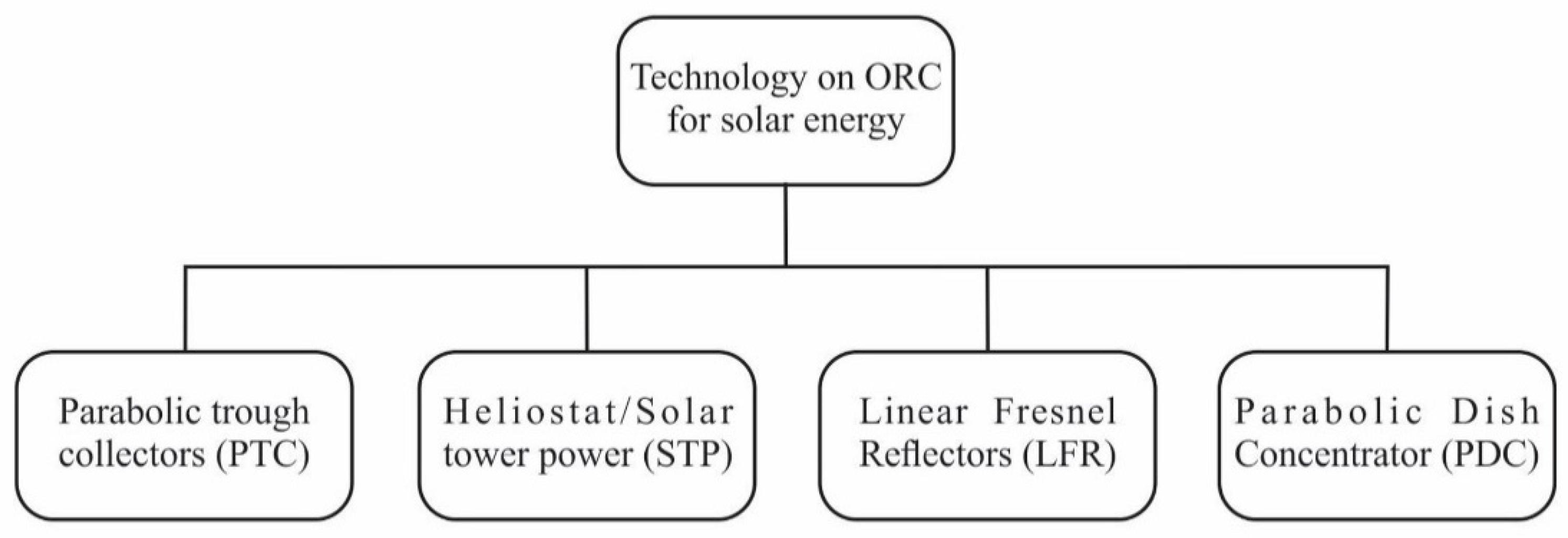
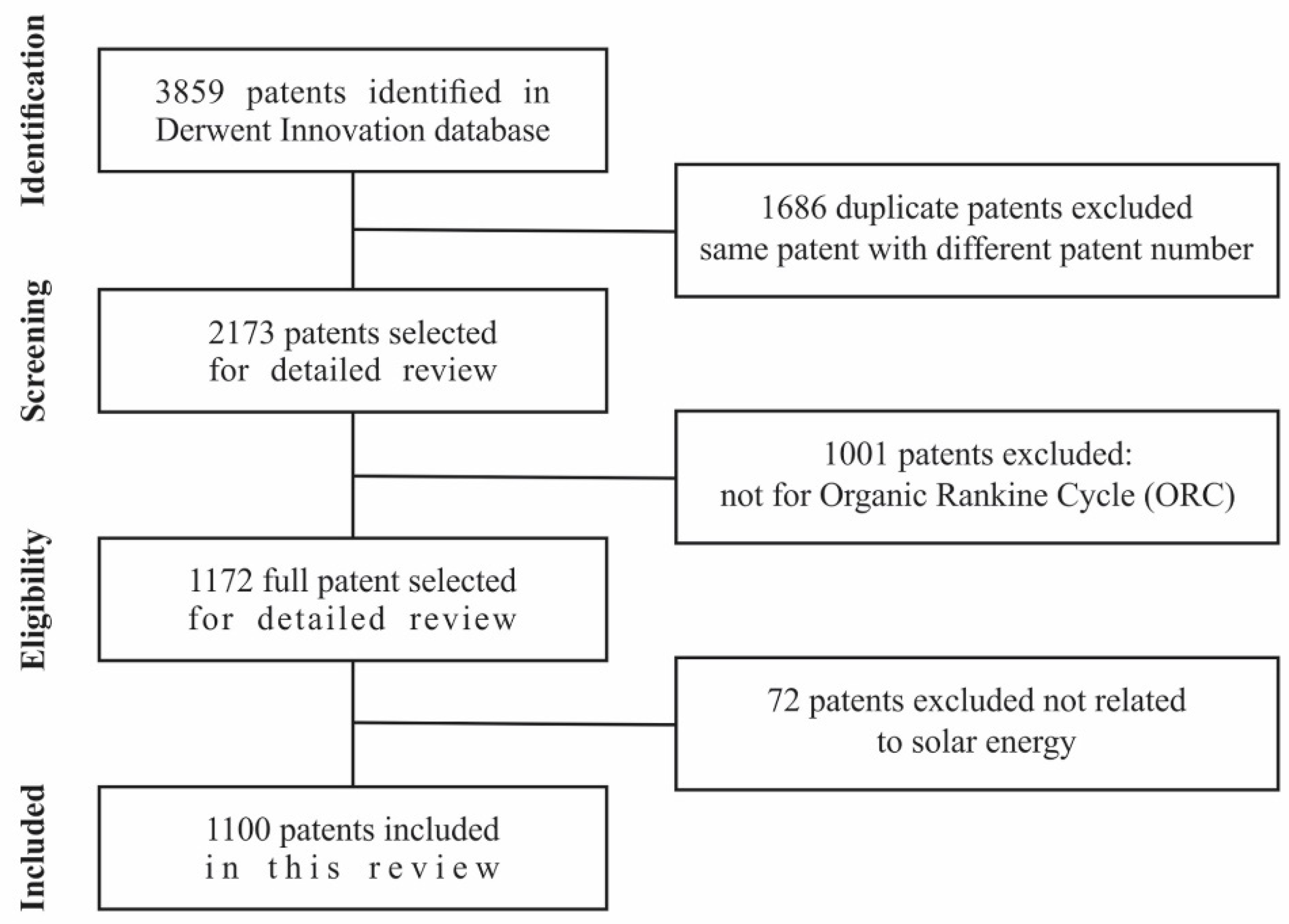
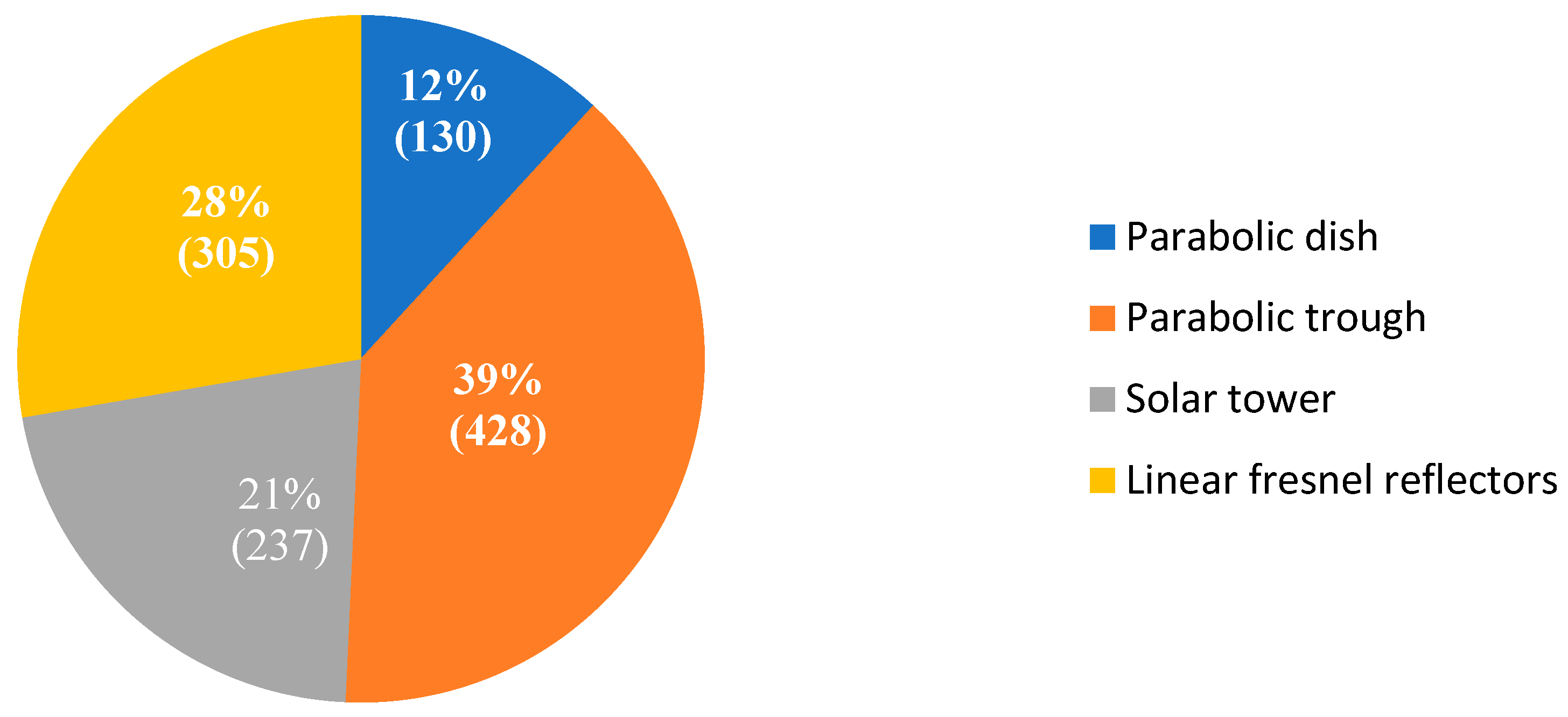






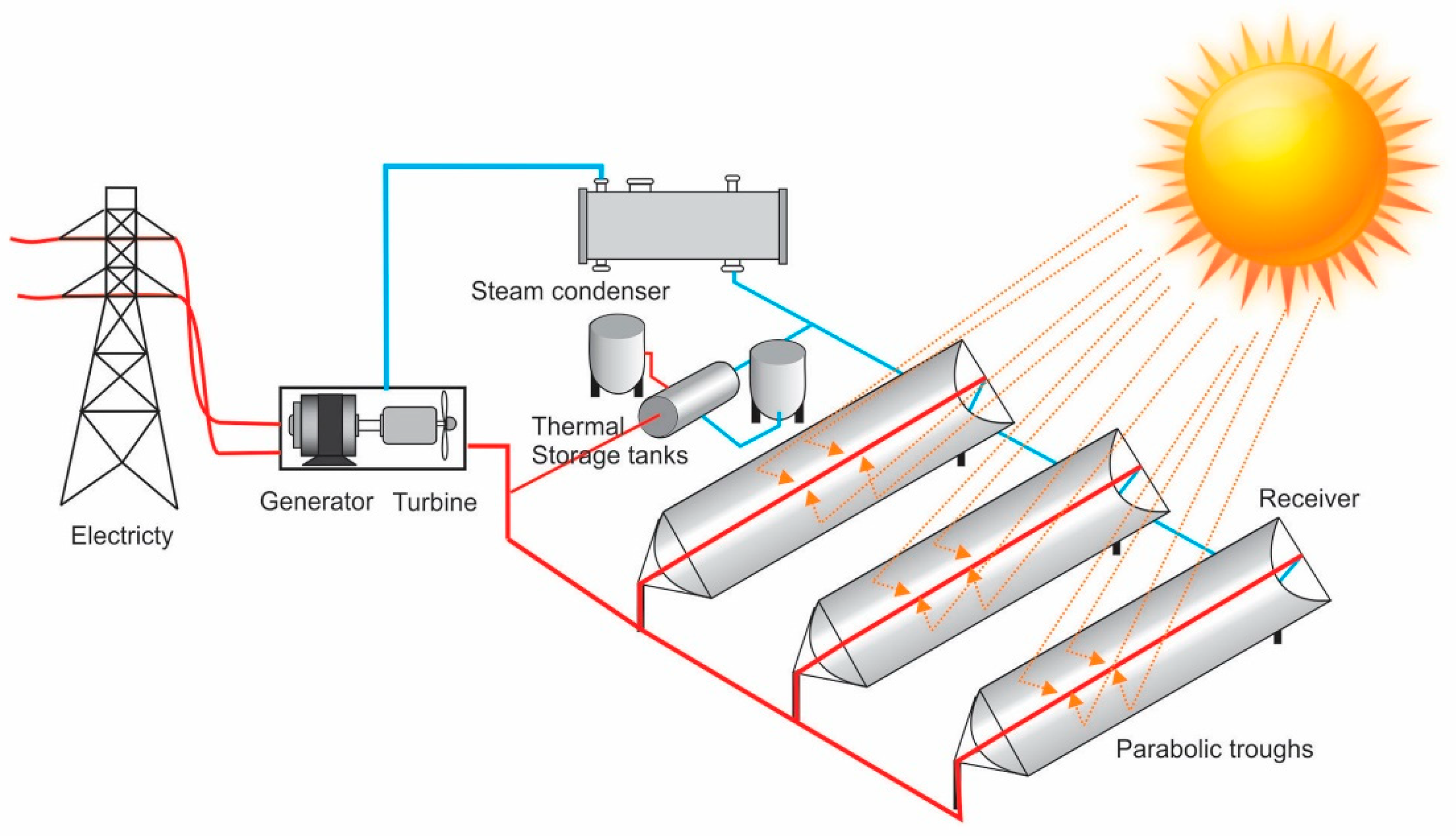

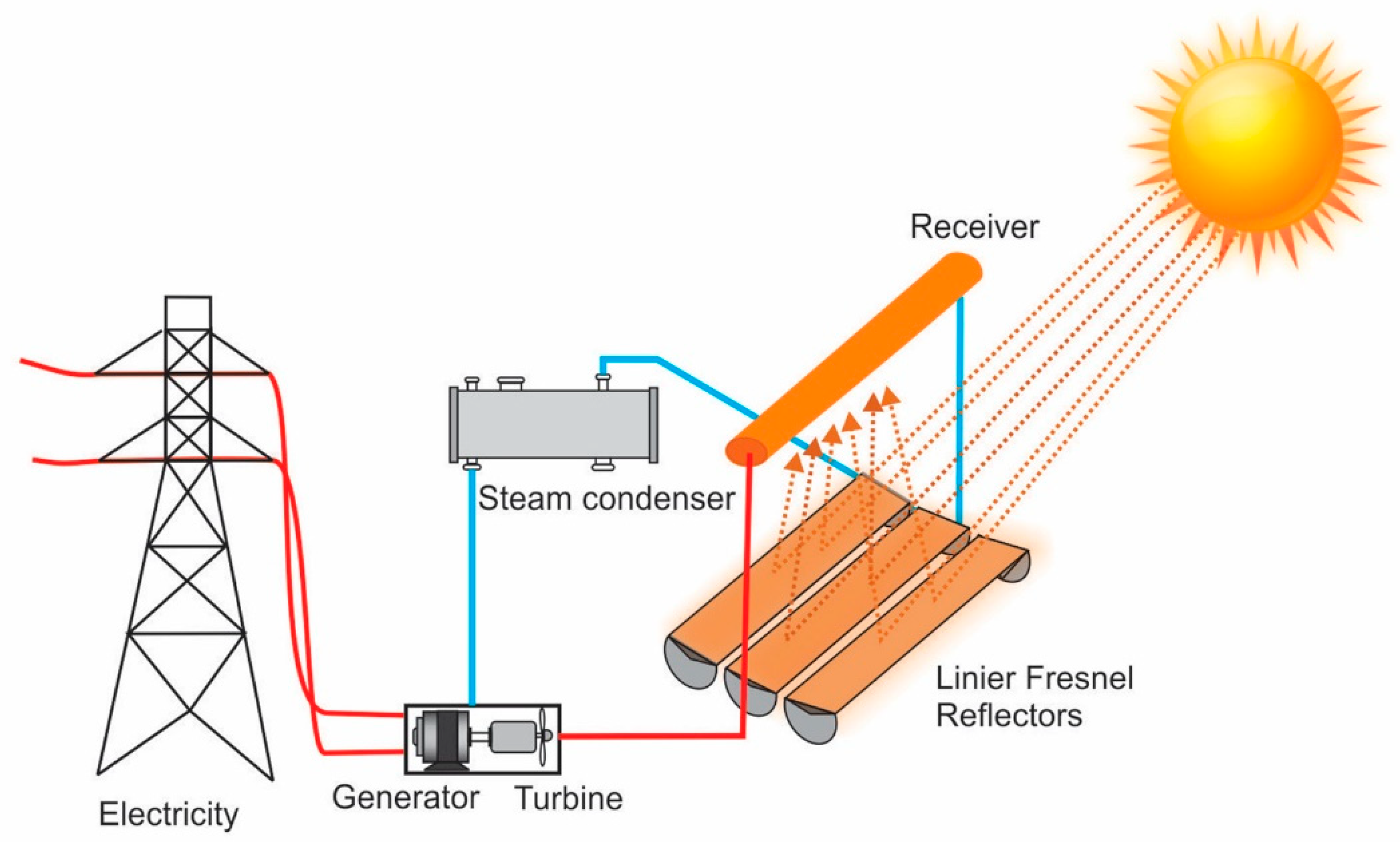
| Technologies in ORC Application for Solar Energy | Keyword Terms |
|---|---|
| Parabolic trough | Search (Solar energy AND Parabolic trough AND Technology) {Title, Abstract, Claims} |
| Solar tower | Search (Solar energy AND Solar tower AND Technology) {Title, Abstract, Claims} |
| Fresnel trough | Search (Solar energy AND Linear Fresnel AND Technology) {Title, Abstract, Claims} |
| Parabolic Dish | Search (Solar energy AND Parabolic Dish AND Technology) {Title, Abstract, Claims} |
| Date | Patent Titles | Patent Number | Inventors |
|---|---|---|---|
| 2018-03-02 | Solar energy overlapping Rankine cycle power generation system with different exothermic modes | CN207064169 (U) | Li Jing; Pei Gang; Gao Guangtao; Ren Xiao; Ji Jie |
| 2018-03-08 | Combined Solar Thermal Power Generation System | US2018066635 (A1) | Zhang Yanping; Zhang Cheng; Huang Shuhong |
| 2017-08-18 | Photovoltaic and photo-thermal coupled thermoelectric generation system and method | CN107061201 (A) | Miao Zheng Zhang Kai |
| 2017-01-18 | Organic Rankine Cycle power generation device and flow path control method for heat collecting fluid | CN106337788 (A); CN106337788 (B) | Xu Rongji; Yan Meiyu; Luan Yitao; Xu Shuhui Wang Ruixiang; Wang Huasheng |
| 2017-01-11 | Organic Rankine Cycle power-generation device and flow control method for heat collecting liquid | CN106321381 (A) | Xu Rongji; Yan Meiyu Zhang Xiaohui; Wei Yicong; Wang Ruixiang; Xu Shuhui |
| 2016-07-06 | Formula of directly expanding solar thermal power generation system based on overlapping Rankine cycle | CN205370873 (U) | Ji Jie; Li Jing; Li Pengcheng; Pei Gang |
| 2016-04-06 | Direct-expansion solar thermal power generation system based on cascade Rankine cycle | CN105464914 (A) | Ji Jie; Li Jing; Li Pengcheng; Pei Gang |
| 2013-06-12 | Solar power and biomass power complementing organic Rankine cycle cogeneration system | CN103147945 (A); CN103147945 (B) | Ye Xuemin; Wang Jia Li Chunxi; Tong Jialin |
| 2012-10-17 | Slotted solar intermediate/low-temperature ORC (organic Rankine cycle) thermal power generator | CN102734095 (A) | Jiancheng Zhang |
| 2011-10-05 | Slotted solar middle-low-temperature ORC (Organic Rankine Cycle) thermal power generation device | CN202001231 (U) | Jiancheng Zhang |
| 2010-11-10 | Heat pipe solar organic Rankine cycle low temperature thermal power generation system | CN201627689 (U) | Jing Li; Jie Ji; Gang Pei |
| 2010-09-15 | Direct expansion type solar low temperature thermal power generation and photovoltaic power generation combined system | CN201582063 (U) | Jie Ji; Jing Li; Gang Pei |
| 2010-08-11 | Direct-expansion type solar energy low-temperature thermal power generation and photovoltaic power generation compound system | CN101798996 (A) | Jie Ji; Jing Li; Gang Pei |
| 2010-06-30 | Heat pipe type solar energy ORC (organic Rankine cycle) low-temperature thermal power generating system | CN101761461 (A); CN101761461 (B) | Jie Ji; Jing Li; Gang Pei |
| 2010-07-01 | Rankine-Brayton Engine Powered Solar Thermal Aircraft | US2010162702 (A1); US8132412 (B2) | Bennett Charles L |
| 2009-12-30 | Inner thermal storage solar low-temperature thermal power generation system | CN101614196 (A); CN101614196 (B) | Jie Ji; Jing Li; Gang Pei |
| 2009-12-23 | Solar-energy low-temperature thermal power-generation and photovoltaic power-generation combination system | CN101608606 (A); CN101608606 (B) | Jing Li; Gang Pei; Jie Ji |
© 2019 by the authors. Licensee MDPI, Basel, Switzerland. This article is an open access article distributed under the terms and conditions of the Creative Commons Attribution (CC BY) license (http://creativecommons.org/licenses/by/4.0/).
Share and Cite
Mahlia, T.M.I.; Syaheed, H.; Abas, A.E.P.; Kusumo, F.; Shamsuddin, A.H.; Ong, H.C.; Bilad, M.R. Organic Rankine Cycle (ORC) System Applications for Solar Energy: Recent Technological Advances. Energies 2019, 12, 2930. https://doi.org/10.3390/en12152930
Mahlia TMI, Syaheed H, Abas AEP, Kusumo F, Shamsuddin AH, Ong HC, Bilad MR. Organic Rankine Cycle (ORC) System Applications for Solar Energy: Recent Technological Advances. Energies. 2019; 12(15):2930. https://doi.org/10.3390/en12152930
Chicago/Turabian StyleMahlia, T. M. I., H. Syaheed, A. E. Pg Abas, F. Kusumo, A. H. Shamsuddin, Hwai Chyuan Ong, and M. R. Bilad. 2019. "Organic Rankine Cycle (ORC) System Applications for Solar Energy: Recent Technological Advances" Energies 12, no. 15: 2930. https://doi.org/10.3390/en12152930
APA StyleMahlia, T. M. I., Syaheed, H., Abas, A. E. P., Kusumo, F., Shamsuddin, A. H., Ong, H. C., & Bilad, M. R. (2019). Organic Rankine Cycle (ORC) System Applications for Solar Energy: Recent Technological Advances. Energies, 12(15), 2930. https://doi.org/10.3390/en12152930







